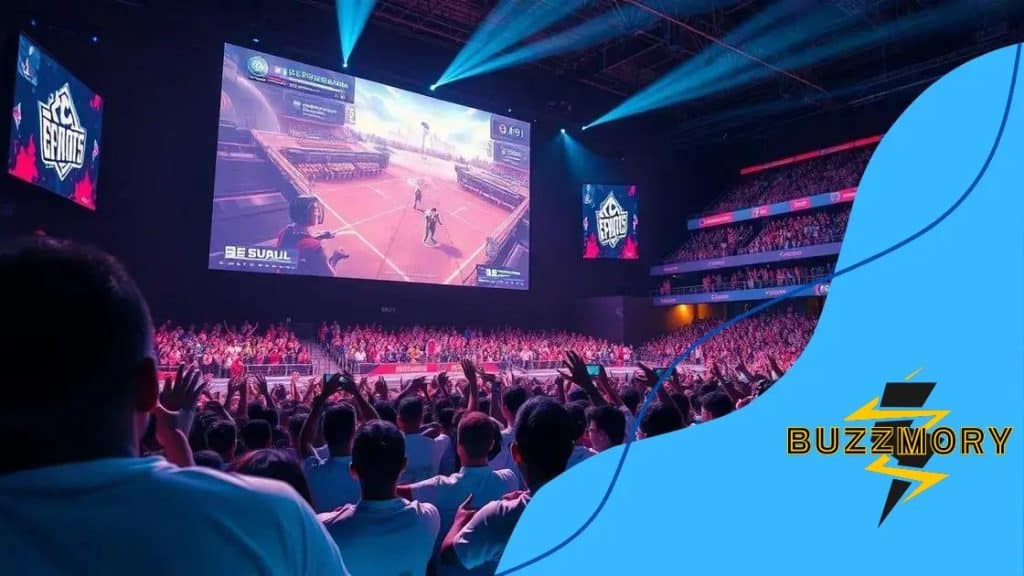How e-sports are influencing mainstream media content

How e-sports are influencing mainstream media content includes increased collaboration with traditional outlets, innovative formats for viewer engagement, and the use of analytics to tailor content for diverse audiences.
How e-sports are influencing mainstream media content is a fascinating topic that highlights the crossover between gaming and traditional media. Have you noticed the growing presence of e-sports in everyday entertainment? Let’s dive deeper.
The rise of e-sports in popular culture
The rise of e-sports in popular culture has transformed how we view and engage with entertainment. Over the past few years, games like League of Legends and Fortnite have captivated audiences and drawn in millions of viewers, not just at home but also in large arenas around the world.
Shifts in Entertainment
This phenomenon has changed the landscape of entertainment, where e-sports now compete with traditional sports for viewership. More people are tuning into gaming events, which are broadcasted on platforms like Twitch and YouTube, often outpacing conventional sporting events in terms of viewership numbers.
Impact on Audience Demographics
The demographic of e-sports viewers is also noteworthy. Many are younger, tech-savvy individuals who engage with content on multiple devices. This shift influences how media companies craft their strategies to attract younger audiences. To understand the appeal better, consider these points:
- Interactive experiences through live-streaming.
- Engaging commentary that connects with the millennial mindset.
- Community building through social media platforms.
- Reward systems, like in-game achievements, that keep players involved.
Moreover, brands are recognizing the potential reach of e-sports. Traditional advertisers are diverting budgets to e-sports sponsorships, seeing them as a way to engage a passionate audience. The collaborations between brands and game developers also lead to unique marketing opportunities.
Ultimately, the integration of e-sports into mainstream culture showcases a significant transformation in entertainment. As we observe these shifts, it’s clear that the future will hold even more collaborative efforts between e-sports and traditional media, paving the way for exciting new possibilities.
How traditional media covers e-sports
How traditional media covers e-sports highlights an important evolution in entertainment. As e-sports gain popularity, traditional media outlets are adapting their strategies to engage a growing audience. Major networks and publications have begun to recognize the influence of gaming and are expanding their coverage to keep up with this trend.
Television and Streaming Services
Television networks are now broadcasting e-sports tournaments and events, providing a platform for fans who prefer this format. Additionally, services like ESPN and TBS have featured e-sports programs, which has brought a new level of legitimacy to the gaming scene. The collaboration between gaming companies and media players is increasing.
Print and Online Media Coverage
Print magazines and online articles are also reshaping their content to include e-sports. Coverage now includes player profiles, game reviews, and analysis of competitions. By reporting on e-sports, traditional media outlets attract younger audiences who seek to learn more about their favorite games and players. Here are some common types of coverage:
- Event announcements and previews.
- Interviews with top players and teams.
- Analysis of strategies and gameplay.
- Features on emerging trends in gaming.
The integration of e-sports into traditional media represents a shift in how audiences consume entertainment. By covering gaming events, these outlets are not only drawing in new viewers but also reshaping cultural perceptions of gaming.
As media continues to evolve, expect even more traditional media formats to embrace e-sports, integrating it into their regular programming and content strategies.
The impact of e-sports on advertising strategies

The impact of e-sports on advertising strategies is profound and growing. As the popularity of e-sports continues to rise, brands are increasingly recognizing the value of reaching young, engaged audiences through this medium. Companies are shifting their focus to engage fans in ways that resonate with their interests and lifestyle.
Adapting Campaigns for the E-sports Audience
Advertising in the realm of e-sports requires a different approach compared to traditional advertising. Brands are tailoring their messages to fit the unique culture of gaming. This means creating campaigns that feel organic rather than intrusive. Here are some effective strategies:
- Collaborating with popular streamers and gamers to promote products.
- Creating in-game advertisements that blend seamlessly with the gaming experience.
- Utilizing social media to engage with the gaming community and share content.
- Hosting events and tournaments to build brand loyalty among players.
This shift not only benefits advertisers but also enhances the overall gaming experience for players. Brands that align themselves with e-sports create a positive association, making their products more appealing to gamers.
Data-Driven Advertising
Another significant impact of e-sports on advertising strategies is the use of data analytics. Brands can now analyze viewer habits and preferences, allowing for more targeted advertising. Data collection through platforms like Twitch and YouTube provides insights into audience engagement.
Using this information, companies can craft tailored marketing messages that resonate more with their audiences. The goal is to create a connection between the brand and the gamers, fostering a community around the products.
As e-sports continues to evolve, its impact on advertising will likely grow. Brands that understand and adapt to the culture of e-sports will benefit immensely from the passionate community it has cultivated.
Viewer engagement: e-sports vs traditional sports
Viewer engagement in e-sports versus traditional sports reveals interesting dynamics. With the rise of e-sports, audiences are interacting with games in unique ways that differ from how they engage with conventional sports. This shift is reshaping the way both industries think about their audiences.
Interactive Viewing Experiences
One major difference lies in the interactive nature of e-sports. Viewers can participate in the action by engaging with live streams, voting in real-time, and communicating with streamers through chat. These interactions create a sense of community and involvement that traditional sports often lack.
Audience Demographics
The demographics of e-sports viewers also play a significant role in engagement. Younger audiences are often more tech-savvy and prefer to consume content online, making platforms like Twitch and YouTube popular for e-sports content. In contrast, traditional sports often attract older viewers who may prefer watching on television. Engaging these different audiences requires distinct strategies that resonate with their preferences.
For example, e-sports often uses social media to promote events and connect with fans, offering a more personal experience. In addition, brands targeting e-sports audiences tailor their messages to align with gaming culture.
Community Building
Another impactful aspect of viewer engagement is community building. E-sports fosters a sense of belonging among fans through online groups, forums, and events. Players and fans share experiences, strategies, and support for their favorite teams.
In traditional sports, community often forms around local teams and attending live games. However, the engagement level may not match the direct interaction found within the e-sports community. As e-sports continues to gain prominence, traditional sports may adopt some of these strategies to enhance viewer involvement.
Overall, the differences in viewer engagement between e-sports and traditional sports illustrate a changing landscape in entertainment. Understanding these dynamics is crucial for brands and media organizations aiming to connect effectively with their audiences.
Future trends of e-sports in media
The future trends of e-sports in media are shaping the landscape of entertainment as we know it. With the rapid growth of gaming, various media formats are evolving to incorporate e-sports more prominently. This evolution is not just about gaming but also about how audiences consume content.
Increased Collaboration with Traditional Media
One major trend is the increasing collaboration between e-sports and traditional media outlets. Networks are starting to acquire broadcasting rights for major e-sports tournaments, investing in live coverage that brings these events into mainstream culture. As this partnership grows, we can expect to see more e-sports programming on television channels.
Innovative Content Formats
Another trend is the rise of innovative content formats tailored for engaged viewers. Streaming platforms are leveraging unique formats such as interactive broadcasts, where viewers can influence outcomes or choose camera angles in real-time. This level of engagement is something traditional sports are only beginning to explore.
Diverse content types, including documentaries and behind-the-scenes looks at players and teams, are also on the rise. Fans love getting to know the personalities behind their favorite games, which adds depth to the viewing experience.
Expanding Global Reach
As e-sports continues to expand globally, we are likely to see media outlets catering to international audiences more effectively. Subtitled broadcasts and multilingual commentary are becoming standard to enhance accessibility. More viewers from different countries will mean greater sponsorship opportunities and a broader audience base.
Emerging technologies like virtual and augmented reality are also set to play a crucial role in the future of e-sports media. These technologies can create immersive experiences that transport viewers into the gaming environment, allowing them to feel like they are part of the action.
Finally, data analytics will continue to be a crucial factor in shaping how e-sports content is created and distributed. Understanding viewer preferences will help companies tailor experiences that resonate with their audiences.
The future of e-sports in media is bright and full of possibilities. As technology and engagement strategies evolve, we can look forward to a more integrated and dynamic media landscape.
e-sports on mainstream media is undeniable. As we see traditional media embrace gaming, the boundaries between these realms continue to blur. E-sports brings exciting opportunities for engagement, innovation, and community building. By understanding these trends, we can anticipate how both industries will evolve together.
FAQ – Frequently Asked Questions about E-sports in Media
How is traditional media adapting to e-sports coverage?
Traditional media is beginning to broadcast e-sports events, recognizing their popularity and engaging younger audiences.
What role do streaming platforms play in e-sports?
Streaming platforms like Twitch allow viewers to interact in real-time with e-sports events, enhancing engagement and community.
How do demographics differ between e-sports and traditional sports audiences?
E-sports audiences are often younger and more tech-savvy, while traditional sports viewers typically cover a broader age range.
What future trends should we expect for e-sports in media?
Expect more collaborations between e-sports and traditional media, innovative interactive formats, and wider global reach due to improved technology.





